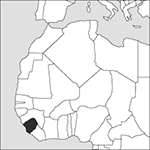A tropical West African country with an Atlantic coast facing south-west and a fine natural harbour; it is surrounded inland by Guinea and Liberia.
Physical
Swamps spread up river valleys, through a rainforested coastal plain to wooded savannah in the interior.
Economy
Sierra Leone is still recovering from both the civil war of the 1990s and early 2000s and the Ebola outbreak of 2014–15; the country is very poor, with around two-thirds of the workforce engaged in subsistence agriculture. Cocoa and coffee are the main cash crops and important exports; other crops include rice, palm kernels, palm oil, and groundnuts. Other principal exports are diamonds (now internationally accepted once more after the illegal trade in ‘blood diamonds’ of the civil war years), iron ore, rutile (titanium ore), and bauxite, and the main industry is mining.
History
The Portuguese navigator Pedro de Cintra reached it in 1462, at about the time the Temne, its chief inhabitants, were reaching the coast. During the 16th and 17th centuries the slave trade and piracy attracted many Europeans, including English, so that the coast has a very mixed population. In 1772 Britain declared that any escaped slave who came to Britain would automatically become free. In 1787 the Anti-Slavery Society bought the coastal territory from the local ruler as a haven for slaves found destitute in Britain. British philanthropists organized their transport to Cape Sierra Leone, where Freetown was established. In 1791 Alexander Falconbridge formed a transport company, the Sierra Leone Company, landing the first colonists at Freetown in 1792. It became a crown colony in 1808. After 1815 British warships who captured slave ships brought freed captives there. During the 19th century the hinterland of Sierra Leone was gradually explored and in 1896 it became a British protectorate, which remained separate from the colony of Freetown until 1951. The country gained its independence under Prime Minister Sir Milton Margai (1895–1964) in 1961, but after his death electoral difficulties produced two military coups before some stability was restored by the establishment of a one-party state under Dr Siaka Stevens. Food shortages, corruption, and tribal tensions produced serious violence in the early 1980s, and in 1985 Stevens retired in favour of Major-General Joseph Saidu Momoh. As head of state, he retained a civilian cabinet with the All People’s Congress (APC) the sole legal party; its rule was deeply corrupt. In April 1992 an army coup, led by Captain Valentine Strasser, ousted Saidu Momoh and formed a National Provisional Defence Council, committed to the elimination of corruption and the restoration of the economy. Although the ban on political parties imposed in 1992 was lifted in 1995, actions by rebel forces opposed to the government intensified. In 1996 Strasser was ousted by his deputy, Captain Julius Bio, who took over as head of state. In March 1996 democratic elections were won by Ahmad Tejan Kabbah (1932–2014), who became President of a civilian government. This government was overthrown in a military coup in 1997, but Nigerian forces retook the capital in 1998 and the President was reinstated. However, later in 1998 members of the deposed military regime joined by the left-wing Revolutionary United Front attacked Freetown causing considerable damage. The Nigerians returned to rout the rebels in January 1999. Despite the deployment of a UN peacekeeping force later that year, the civil war continued until a ceasefire was agreed in 2001. The UN established a special court in 2002 to try war crimes committed in the savage fighting; in 2012 it convicted Charles Taylor, the former President of Liberia, of war crimes and crimes against humanity. Kabbah won the presidential election in 2002 and in 2003 a truth and reconciliation commission was established. The UN peacekeeping force was withdrawn in 2005. Ernest Bai Koroma was elected President in 2007 and re-elected in 2012. In 2014 the country was plunged into a humanitarian and economic crisis as a result of the Ebola epidemic. A state of emergency was declared and movement restrictions were enforced. The outbreak continued into 2016, by which time it had killed nearly 4,000 people and disrupted the lives of everyone in the country. In October 2015, Koroma launched a plan to reform government and the economy, to help the country recover and to make it more resilient in the future.

Source: MAPS IN MINUTES™ © RH Publications (1997)
Capital:
Freetown
Area:
71,740 sq km (27,699 sq miles)
Population:
5,612,685 (2013 est)
Currency:
1 leone = 100 cents
Religions:
Muslim 60%; traditional beliefs 30.0%; Christian 10.0%
Ethnic Groups:
Temne 35.0%; Mende 31.0%; Limba 8.0%; Kono 5.0%
Languages:
English (official); Krio (English creole); Mende; Temne; other local languages
International Organizations:
UN; AU; ECOWAS; Commonwealth; Non-Aligned Movement; WTO
- Uthman dan Fodio (1754–1817)
- util
- utilitarianism
- utilities
- utility
- utility calculus
- utility computing
- utility flow diagram
- utility function
- utility maximization
- utility possibility frontier
- utility programs
- utility waste
- utopia
- Utopia Planitia
- UTP
- Utrecht, Peace of (1713)
- utriculus
- UTS
- U-tube manometer
- U-type asteroid
- UU Herculis star
- UV
- uvala
- U-value